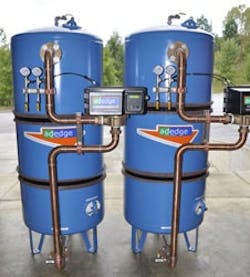| Related Searches from WaterInfoLink.com Filtration System | Iron | AdEdge Technologies | Manganese | Ladd Engineering, Inc. |
In July 2009, AdEdge Technologies, Inc. was contacted by Ladd Engineering, Inc. to provide a proposal for the Brandywine Elementary School in Indiana’s Southern Hancock School District. Shortly thereafter, AdEdge was selected to provide a potable water treatment system to the school to reduce elevated levels of arsenic, iron and manganese that exceeded drinking water standards. Brandywine Elementary School has approximately 330 students and a daily usage of 5,000 gal per day. The selected system was an AdEdge AD26 oxidation/filtration treatment system rated for 65 gal per minute (gpm). Incoming iron concentration is 1.2 milligrams per liter (mg/L), manganese is 0.045 mg/L and arsenic is 0.011 mg/L.
Treatment System
A modular AD26 oxidation/filtration treatment system was designed for the school. Most schools are burdened with limited space for a system, as was the case with Brandywine. The versatility of the modular systems, combined with their smaller footprint because of higher loading rates, allowed design of a system that was accommodated in the existing space so that a separate building or expansion was not needed.
The modular system at Brandywine Elementary consists of two 30-in.-diameter carbon steel vessels with side-mounted control valves, pressure gauges, flow meters and the NSF-approved AD26 media. The carbon steel vessels were plumbed in parallel configuration in the field along with all interconnecting plumbing. The site used its existing chlorination module prior to the AD26 system to optimize the removal process for arsenic, iron and manganese. The modular treatment system is equipped with automatic controls, backwashing features, switches, gauges, flow meters and sample ports for a complete functioning unit. The groundwater supply well following chlorine injection is routed through the system, then to pressure storage.
AdEdge has deployed the AD26 technology in many community and non-community public water system applications successfully throughout the U.S. and Canada for arsenic, iron and manganese.
Performance
The system was designed, fabricated, installed and started up in approximately two months and placed into full-time operation in October 2009. Since commissioning, the system is removing arsenic to non-detect levels. Iron and manganese are both being reduced to trace amounts. IDEM has recognized the AD26 treatment technology as a viable arsenic, iron and manganese removal design for the state of Indiana.
